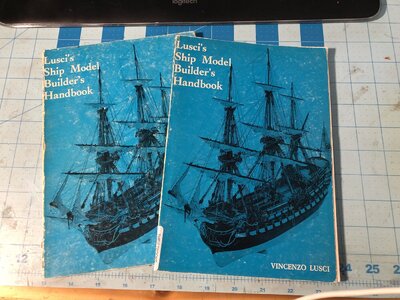OMG that ship looks incredible! Quick fix on those light leaks, glue some black construction paper to the interior surfaces of the planking. Fast and easy as long as you still have access to the inside.
-

Win a Free Custom Engraved Brass Coin!!!
As a way to introduce our brass coins to the community, we will raffle off a free coin during the month of August. Follow link ABOVE for instructions for entering.
You are using an out of date browser. It may not display this or other websites correctly.
You should upgrade or use an alternative browser.
You should upgrade or use an alternative browser.
Sovereign of the Seas - Sergal 1:78 (with hopefully many added details)
Kurt,
Yes, on my mind indeed - thanks for the idea - easy fix...PS: Big thanks for your appreciation of this log so far... determined to open last panel and add lights..
Ordering lights in a.m... glad that Nigel and you pushed me over too do. this ..
..
PS: I kind of new that it was needed
PS2: (add 1/2 a year to this old current build) haha.
PS:3 Thanks to all members and guests that look at this log.
 .....
.....
Yes, on my mind indeed - thanks for the idea - easy fix...PS: Big thanks for your appreciation of this log so far... determined to open last panel and add lights..
Ordering lights in a.m... glad that Nigel and you pushed me over too do. this
PS: I kind of new that it was needed
PS2: (add 1/2 a year to this old current build) haha.
PS:3 Thanks to all members and guests that look at this log.

 .....
.....- Joined
- Nov 6, 2022
- Messages
- 240
- Points
- 113

Must be reverse angle pictures with bowsprit on port side and then on starboard. Beautiful ship in the making!Lastly fixed the beakhead deck errors as well as replacing all other out of scale/non matching grids - now all 1mm throughout all decks.
View attachment 327907View attachment 327908View attachment 327909View attachment 327910View attachment 327911View attachment 327912
May I ask where the ships wheel is located?
Wheels were not in use until 18th century.
Paul, Grant, Greg, Jack, Daniel, Kurt - thanks so much for your very kind posts
Nigel,
Yes indeed – the idea of lights hit me in the face just after I installed the back side of the outer windows. I did not think that they (all the windows) would SO “blacken out” all interior details. I have been “obsessing” with this for a week or so. I am so tempted to in-fact remove the last upper cover plate to regain access to the two floors as well as the inner gallery decks.
View attachment 356389View attachment 356390View attachment 356391
I did see the youtube video of the Soleil along with lighting, and their lighting kit. It won’t work for this application in that it requires AA or AAA batteries.
The solution will be for me to again purchase LED’s from Evan Designs ( a sponsor here as SoS) as I did for my Santisima cross section. His lights require a small flat battery as well as incorporating a small on/off switch. Santisima below (entire build log is here at SoS). He also has a blinking option also available..
View attachment 356398View attachment 356399View attachment 356400View attachment 356401
TBD – I will order lights and add needed inner seals. I don’t think that for this build I will construct lantern housings –but, I do want to also light the inner balconies as well as the upper and lower officer quarters. Fun,fun,fun,….
That said the elephant left in the room are five of these lanterns YIKES hahaha… Found here – on youtube ---- really nice work.
View attachment 356402
Cheers,
John
I have Artesania's kit and you do have the option to use watch batteries.It does not say that in their marketing.I bought it for Soleil Royal but given I am adding full interior now, it is about 100 LEDs short
Kind Regards
Nigel
There was no wheel with ropes and pulley running to the tiller. In the early 17th century and before, ships were steered with a whipstaff. The helmsman operated it from under the halfdeck or from a room on a sublevel below the main deck or upper gun deck. The helmsman could often look forward out portals across the main deck to hear orders from officers above, or if the helm is located too deep within the ship, orders were relayed down to the helmsman.May I ask where the ships wheel is located? It must be below deck.
From zu Mondfeld:
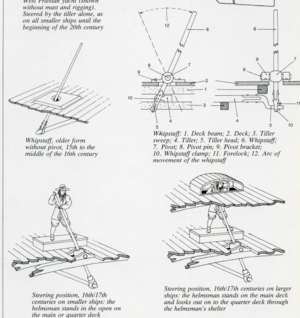
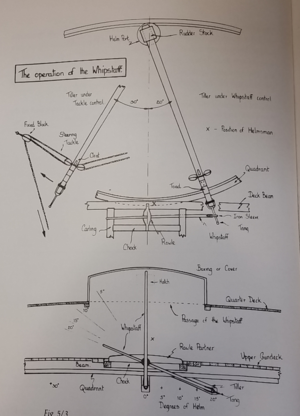
Working whipstaff on model of HMS Sovereign of the Seas. The Sovereign is probably the largest ship capable of being controlled using a whipstaff. The ships wheel has many advantages over the whipstaff, foremost being the ease of which a heavy rudder under great force can be positioned and held. It probably took more than one person to hold the whipstaff with the rudder at extreme angles if heavy seas.
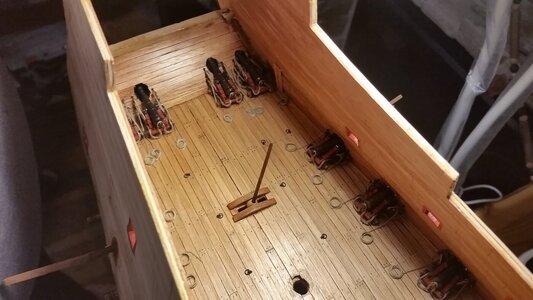
The tiller protrudes from the transom, and will be incorporated into the rudder later in the build. The tiller and whipstaff are positioned "hard to larboard".
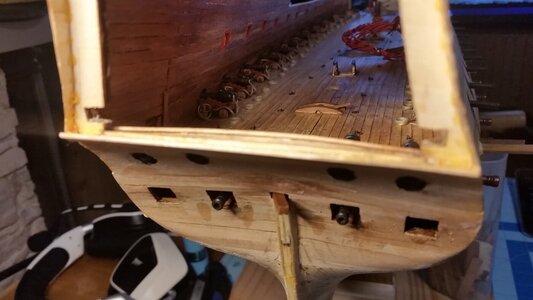
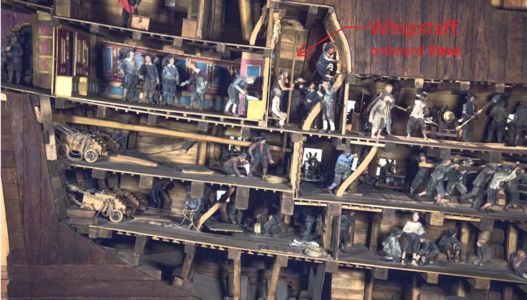
Last edited:
Kurt,
hahaha you just beat me to it - I was putting together some images from the McKay book and images of the Vasa - Dutch but less than a decade apart.
PS: Awesome work on your Sovereign - your work really captured the mechanism indeed - thanks for your post
PS: I don't have the James Sephton book - Do however have one from Angus Konstam - will look for your suggestion....
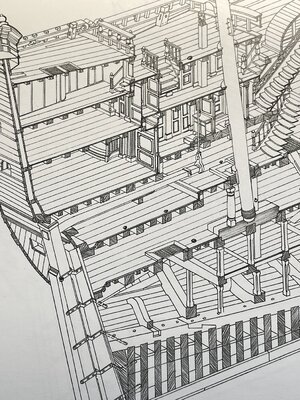
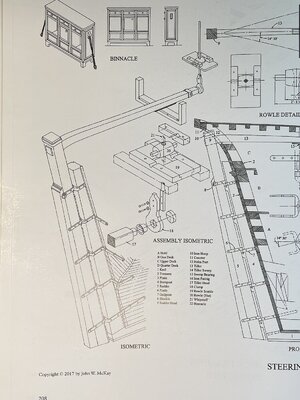
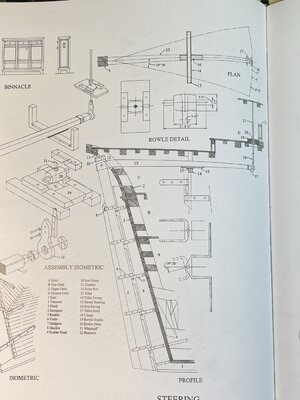
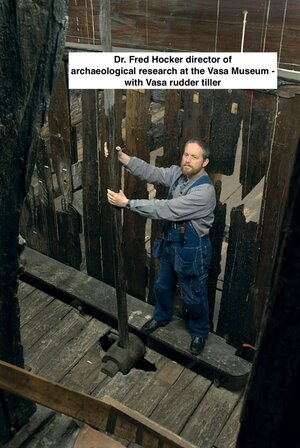
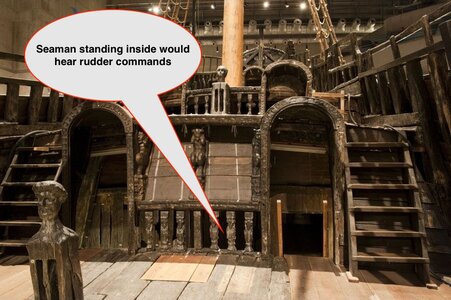
hahaha you just beat me to it - I was putting together some images from the McKay book and images of the Vasa - Dutch but less than a decade apart.
PS: Awesome work on your Sovereign - your work really captured the mechanism indeed - thanks for your post
PS: I don't have the James Sephton book - Do however have one from Angus Konstam - will look for your suggestion....





PS: 2 YIKES so much for my memory these days re; Septhon book. just checked over at Amazon  it responded;
it responded;
You purchased a Kindle format of this item on June 8, 2021.
You purchased a Kindle format of this item on June 8, 2021.
Angus' book is more historical background, not construction details helpful for a modeler like Sephton's book is. By the way, McKay has the rudder tiller on the wrong deck, as is the whipstaff. Don't follow that example. He really should have researched details like that before writing his book. Always question his information before you use it. A lot of it is good, even great, but some truly basic things are not, and some of those errors are carried over from his sources. Even John Payne, Willem Van de Velde and Peter Lely have errors that need to be spotted and avoided.Kurt,
hahaha you just beat me to it - I was putting together some images from the McKay book and images of the Vasa - Dutch but less than a decade apart.
PS: Awesome work on your Sovereign - your work really captured the mechanism indeed - thanks for your post
PS: I don't have the James Sephton book - Do however have one from Angus Konstam - will look for your suggestion....
View attachment 356555View attachment 356556View attachment 356557View attachment 356558View attachment 356559
- Joined
- Nov 6, 2022
- Messages
- 240
- Points
- 113

Novice am I.Wheels were not in use until 18th century.
Good morning. Man they cramped the crew into this space. I wonder what the degree of leverage was with this system. I imagine the helmsman must have been a fairly robust and fit individual. This is not a small vessel. Cheers GrantThere was no wheel with ropes and pulley running to the tiller. In the early 17th century and before, ships were steered with a whipstaff. The helmsman operated it from under the halfdeck or from a room on a sublevel below the main deck or upper gun deck. The helmsman could often look forward out portals across the main deck to hear orders from officers above, or if the helm is located too deep within the ship, orders were relayed down to the helmsman.
From zu Mondfeld:
View attachment 356550
View attachment 356551
Working whipstaff on model of HMS Sovereign of the Seas. The Sovereign is probably the largest ship capable of being controlled using a whipstaff. The ships wheel has many advantages over the whipstaff, foremost being the ease of which a heavy rudder under great force can be positioned and held. It probably took more than one person to hold the whipstaff with the rudder at extreme angles if heavy seas.
View attachment 356553
The tiller protrudes from the transom, and will be incorporated into the rudder later in the build. The tiller and whipstaff are positioned "hard to larboard".
View attachment 356552
View attachment 356554
You won't be after you use this forum as a reference and build one model. Five years ago I was the novice asking the same questions.Novice am I.
Hi Kurt,Angus' book is more historical background, not construction details helpful for a modeler like Sephton's book is. By the way, McKay has the rudder tiller on the wrong deck, as is the whipstaff. Don't follow that example. He really should have researched details like that before writing his book. Always question his information before you use it. A lot of it is good, even great, but some truly basic things are not, and some of those errors are carried over from his sources. Even John Payne, Willem Van de Velde and Peter Lely have errors that need to be spotted and avoided.
Why do you think mckay put the tiller on the wrong deck. I know there is debate about that but it is the same spot as where the Lely painting shows it. On the second gun deck.
I have never found a clear explanation why that would be the wrong deck? It would actually bring the helmsman closer to the hald deck from where the orders were given, sounds logical to me. Just curious.
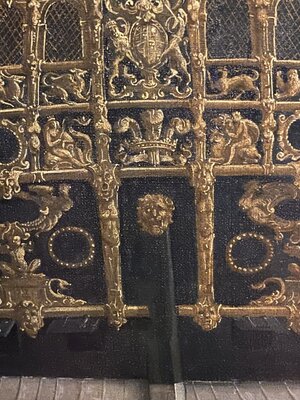
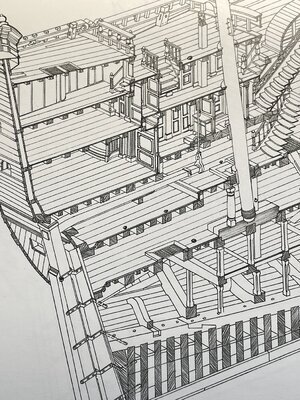
I believe that the tiller location as shown in the Peter Lely painting, and subsequently McKay's interpretation, is incorrect based on the following:Hi Kurt,
Why do you think mckay put the tiller on the wrong deck. I know there is debate about that but it is the same spot as where the Lely painting shows it. On the second gun deck.
I have never found a clear explanation why that would be the wrong deck? It would actually bring the helmsman closer to the hald deck from where the orders were given, sounds logical to me. Just curious.
View attachment 356695
View attachment 356696
"This book not only shows a square stern, but a bizarre square stern in which the flat portion extends below the waterline almost to the keel. This would absolutely ensure a rough, turbulent flow of water to the rudder, which would thereby be rendered quite useless. The rudder itself has problems. Its head extends partly into a huge hole in the counter as in the 18th century, and the tiller enters the hull beneath the upper deck rather than beneath the middle deck as it should. There is no sign of a sweep for the tiller and no gooseneck. From the text, the author seems not to understand that the whipstaff slid THROUGH the rowle right to its end, which is why the helm could swing 20 degrees." - Frank L. Fox
"And now we turn our attention once more to the stern painting that McKay has such great faith in. This rendition of the stern is far from perfect but I'm simply going to concentrate on one of them because I know it caused what I and the experts consider a massive blunder. In the painting the rudder head is shown as being above the middle deck chase ports. From this McKay has brought the tiller in directly below the upper deck beams and has the whipstaff on the upper deck. I challenge him or anyone else to show me a picture or a contemporary model of a large seventeenth century ship with that arrangement. The rudder head and tiller are always just under the middle deck on a three decker and under the upper deck on a two decker. No exceptions. All other depictions of the Sovereign where this is visible have it entering in the standard position. I wouldn't trust the stern painting for anything other than the carvings. I definitely wouldn't even consider trying to get deck placements from it." - Charles Aldridge
Now that we are on the topic of the rudder, I just came across a piece of information that is contrary to how I incorporated the whipstaff in my model from James Sephton's book:
"She was steered, not with a whipstaff, as was the Vasa, but with relieving tackles. Such tackles rove from either side of the tiller to convenient eye bolts to port and starboard. By hauling away on one fall, and slackening off on the another, the rudder could be controlled. The relieving tackles may have been similar to gun tackles. Each relieving tackle was probably a simple two-block three-fold purchase, viz. a luff or a jigger tackle. Mounted on the deck before the tiller was the bittacle (obsolete term for binnacle), a square frame of deal board in which stood the ship's magnetic compass and night lights." - James Sephton
It does seem probable that HMS Sovereign of the Seas was too large a vessel to be steered using only the whipstaff. I would like to know what James Sephton drew upon for information to make him believe that tackles were used instead. Other sources believe a whipstaff was used on HMS Sovereign of the Seas.
Kurt,
As I mentioned in our PM - your knowledge is that of a sage -
 very impressive knowledge base...
very impressive knowledge base...
Cheers,
As I mentioned in our PM - your knowledge is that of a sage -

 very impressive knowledge base...
very impressive knowledge base...Cheers,
Allthough the gentleman post this:
The rudder head and tiller are always just under the middle deck on a three decker and under the upper deck on a two decker. No exceptions.
Then we have Vasa which just differs 10 years from SotS and yes is Dutch . But look where the tiller is.
. But look where the tiller is.
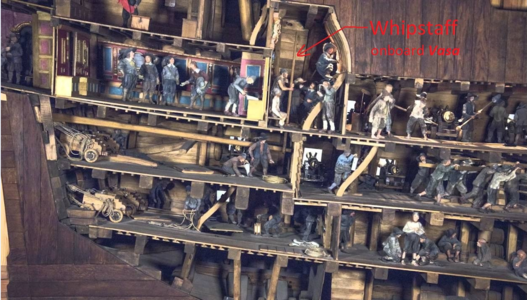
Yes below the lower deck but above the gunners room and just below the great cabin.
SotS was something new, a development towards the later three deckers so I still find it plausible that the tiller was one deck higher, we just don t know.
The rudder head and tiller are always just under the middle deck on a three decker and under the upper deck on a two decker. No exceptions.
Then we have Vasa which just differs 10 years from SotS and yes is Dutch

Yes below the lower deck but above the gunners room and just below the great cabin.
SotS was something new, a development towards the later three deckers so I still find it plausible that the tiller was one deck higher, we just don t know.
John love your alteration of the tuck, looks far better then the Sergal version.
Hi John, I have enjoyed following your build. I have learned so much from reading all of the great comments, and watching you create something really beautiful.
However, I see something that just doesn't seem right. If I'm out of line here, I apologize, but ...
how do you access the starboard head (?). Terry
However, I see something that just doesn't seem right. If I'm out of line here, I apologize, but ...
how do you access the starboard head (?). Terry





